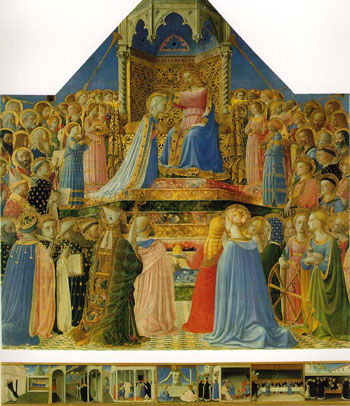
Coronation of the Virginalso known as Le Couronnement de la Vierge

|
Coronation of the Virgin
The ‘Coronation of the Virgin’, (one of three panels), believed to be commissioned by the Gaddi family, adorned one of the altars of the monastery of San Domenico at Fiesole where the artist Fra Angelico once served as a prior. Including the Coronation of the Virgin, this artist contributed 35 religious paintings, always saying a prayer before he was moved by the spirit to paint.
A 14th century altarpiece from the Italian Renaissance period, ‘Coronation of the Virgin’ is believed to be one of Angelico’s most popular works of art. In preparation for the task at hand, he sanded down the panels to a smooth finish and then applied a coating of gypsum paste, or used his signature (hammering on) method to weave intricate designs with gold. Brilliant colors including heavenly blues and pinks contrast against a dark background. His use of perspective and the physicality of his subjects denote a Masaccio influence. Its pyramidal structure and formation allows the subjects in the painting to be viewed without obstruction.
Biographer and painter Georgio Vasari (1511-1574) referred to Fra Angelico in the publication ‘Lives of the Artists’ as having “a rare and perfect talent.” In his second edition of “The Lives” (1550), he states “the artist surpassed his greatest excellence and the understanding of his craft in a panel in which Jesus Christ crowns Our Lady among an infinite multitude of male and female saints, so great in number, so well done, and with such varied poses and different expression that one feels incredible pleasure and delight in looking at them.”
Art historian John Pope-Henessey, an authority on the art of the Renaissance, had some opinions of his own about the ‘Coronation of the Virgin’ in regards to whether Fra Angelico was the sole creator. His research would lead him to believe that the inaccuracies in painting concluded that some assistance must have been rendered to bring the artwork to its completion. He regarded this work as “unevenly executed” and argued that, had it been a one man effort, the artist would have delivered a more unified approach to its spatial projection. Henessey also believed the piece to have been unfinished at the time of the artist’s death.
This painting remained in San Domenico until 1812 and was brought to Paris by Vivant Denon who recognized its primitive value as something lacking in France during that period. Over 200,000 people would come to admire this work of art at the Salon Carré in 1814.
The ‘Coronation of the Virgin’ received great praise by Giovanni Rosini a decade later (1840) in his ‘Storia della Pittura Italiana esposta coi monumenti’, which regarded it as the artist’s best work. It is currently exhibited at the Musée du Louvre alongside the other seven predella pictures that represent the story of San Domenico.












